Unit 8 It must belong to Carla SectionB(2a-2e)课件+内嵌音视频
文档属性
| 名称 | Unit 8 It must belong to Carla SectionB(2a-2e)课件+内嵌音视频 | 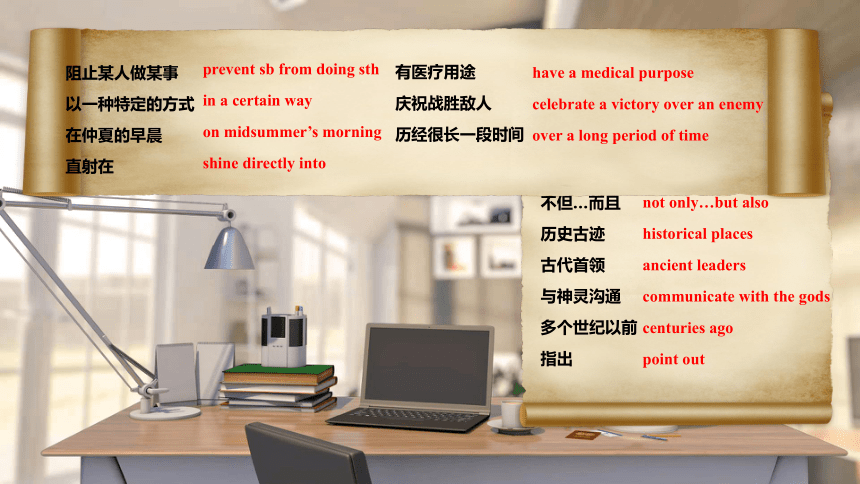 | |
| 格式 | pptx | ||
| 文件大小 | 369.3MB | ||
| 资源类型 | 试卷 | ||
| 版本资源 | 人教新目标(Go for it)版 | ||
| 科目 | 英语 | ||
| 更新时间 | 2022-11-20 22:06:55 | ||
图片预览

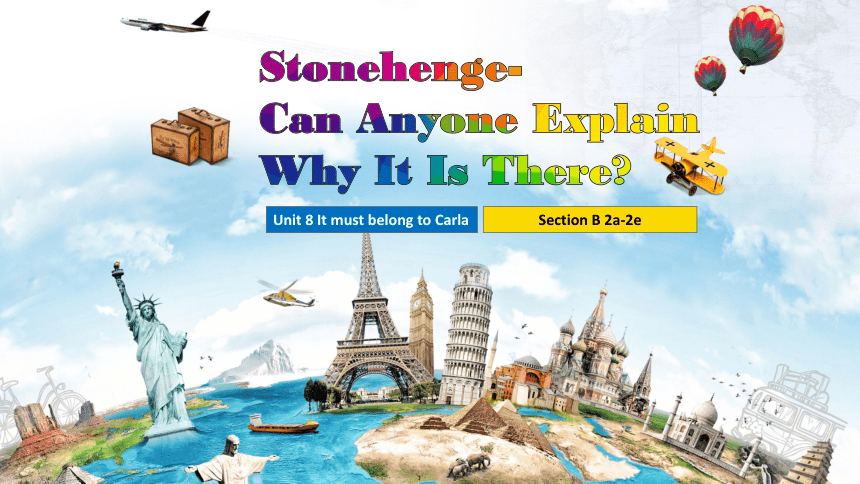

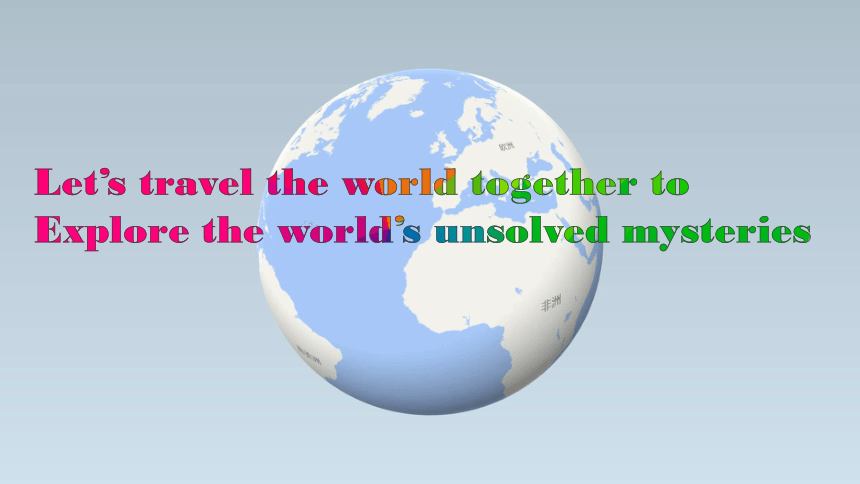
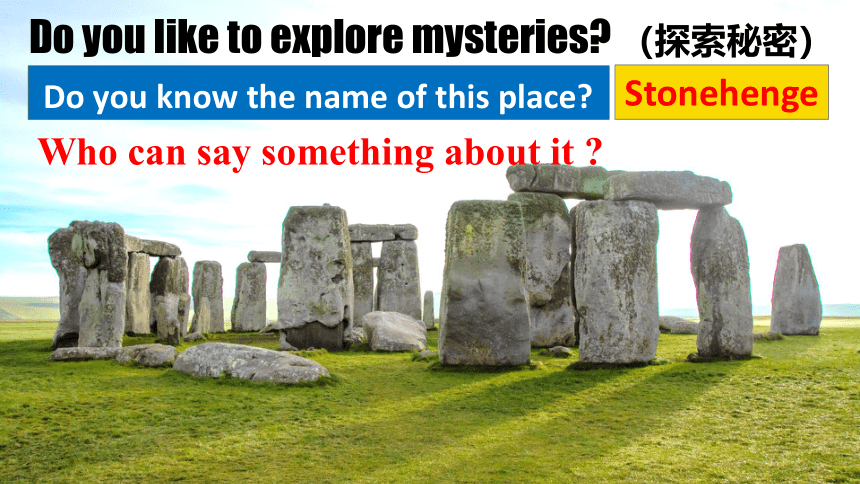
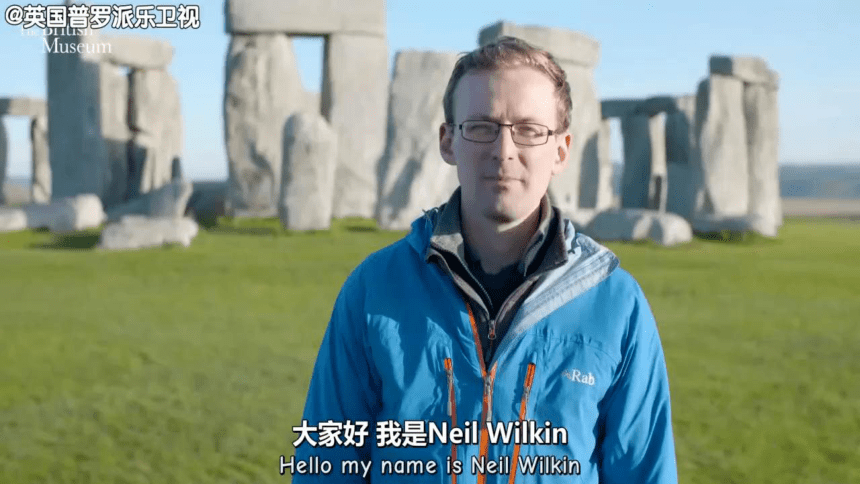
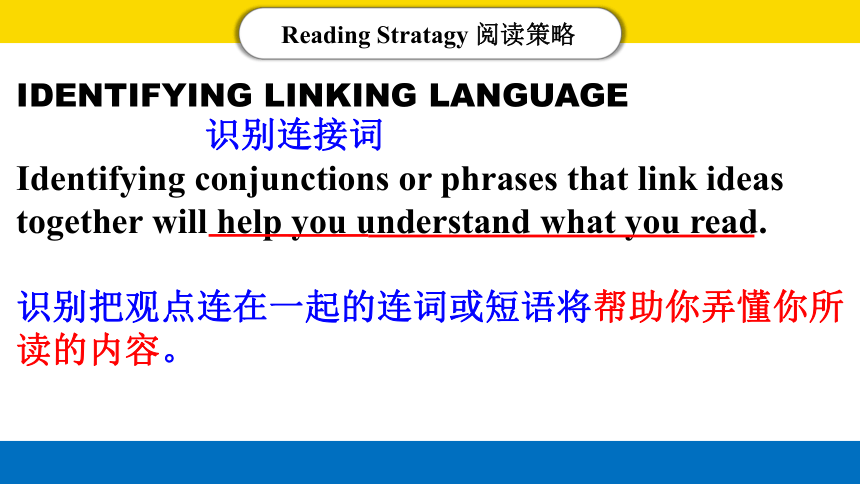
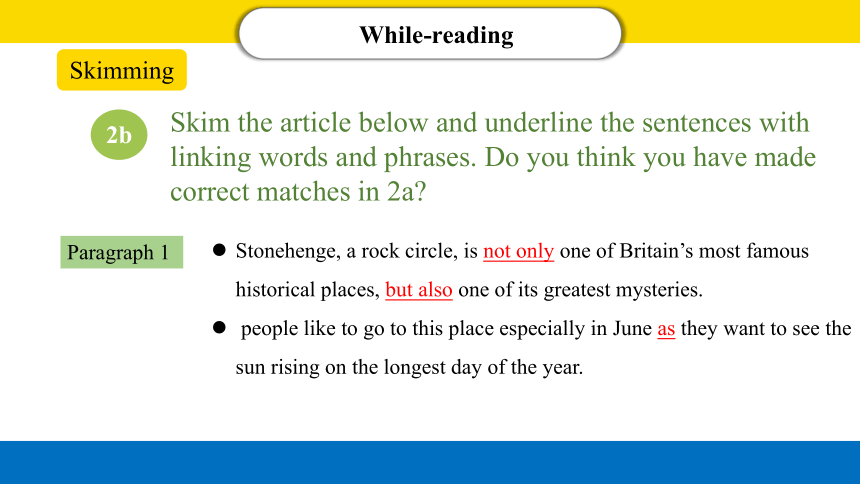
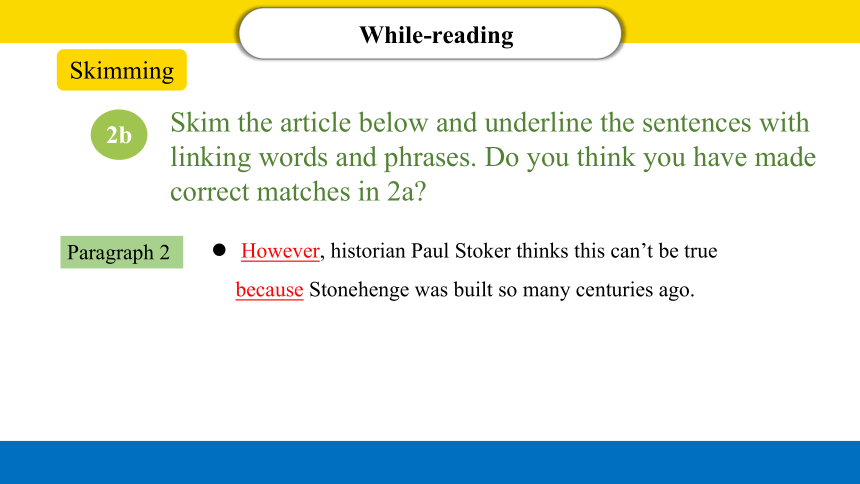
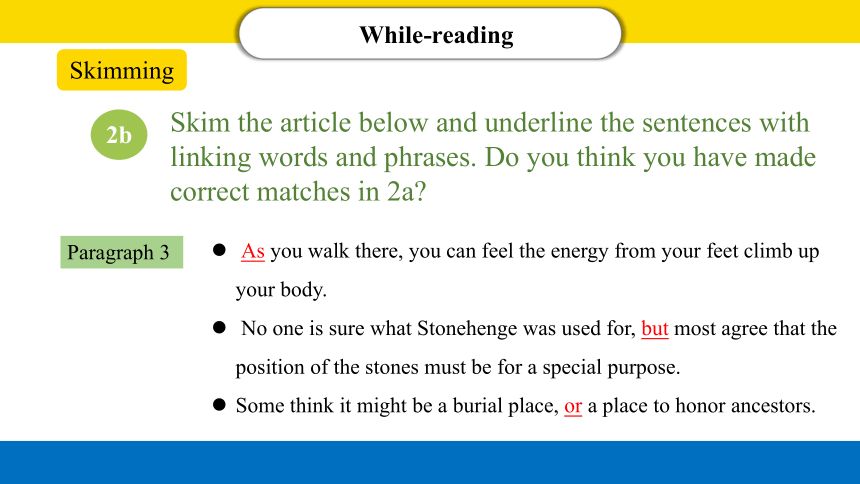
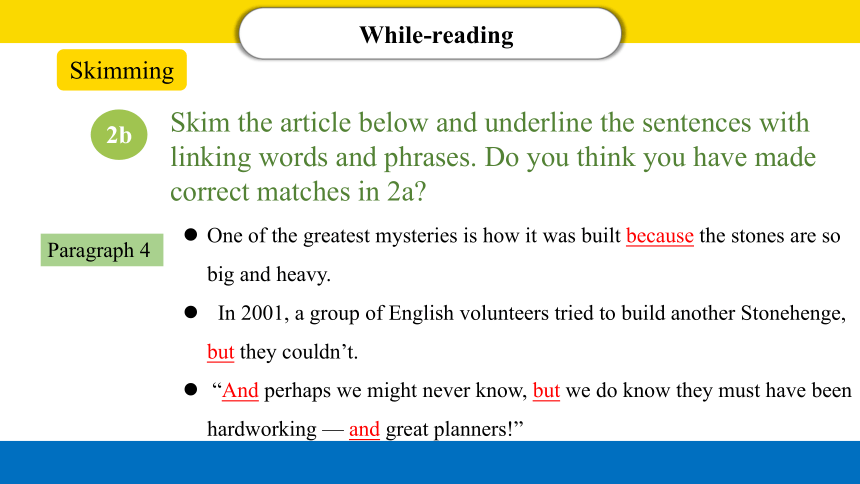

文档简介
New words
不但…而且
历史古迹
古代首领
与神灵沟通
多个世纪以前
指出
not only…but also
historical places
ancient leaders
communicate with the gods
centuries ago
point out
阻止某人做某事
以一种特定的方式
在仲夏的早晨
直射在
有医疗用途
庆祝战胜敌人
历经很长一段时间
prevent sb from doing sth
in a certain way
on midsummer’s morning
shine directly into
have a medical purpose
celebrate a victory over an enemy
over a long period of time
Unit 8 It must belong to Carla
Section B 2a-2e
1.Do you like traveling?
2. Where did you travel?
3. Did you travel to a foreign country?
Do you like to explore mysteries? (探索秘密)
Who can say something about it ?
Do you know the name of this place?
Stonehenge
Reading Stratagy 阅读策略
IDENTIFYING LINKING LANGUAGE
识别连接词
Identifying conjunctions or phrases that link ideas together will help you understand what you read.
识别把观点连在一起的连词或短语将帮助你弄懂你所读的内容。
While-reading
Skim the article below and underline the sentences with
linking words and phrases. Do you think you have made
correct matches in 2a?
Skimming
2b
Stonehenge, a rock circle, is not only one of Britain’s most famous historical places, but also one of its greatest mysteries.
people like to go to this place especially in June as they want to see the sun rising on the longest day of the year.
Paragraph 1
While-reading
Skim the article below and underline the sentences with
linking words and phrases. Do you think you have made
correct matches in 2a?
Skimming
2b
However, historian Paul Stoker thinks this can’t be true because Stonehenge was built so many centuries ago.
Paragraph 2
While-reading
Skim the article below and underline the sentences with
linking words and phrases. Do you think you have made
correct matches in 2a?
Skimming
2b
As you walk there, you can feel the energy from your feet climb up your body.
No one is sure what Stonehenge was used for, but most agree that the position of the stones must be for a special purpose.
Some think it might be a burial place, or a place to honor ancestors.
Paragraph 3
While-reading
Skim the article below and underline the sentences with
linking words and phrases. Do you think you have made
correct matches in 2a?
Skimming
2b
One of the greatest mysteries is how it was built because the stones are so big and heavy.
In 2001, a group of English volunteers tried to build another Stonehenge, but they couldn’t.
“And perhaps we might never know, but we do know they must have been hardworking — and great planners!”
Paragraph 4
2a Match each linking word or phrase with its purpose.
{F5AB1C69-6EDB-4FF4-983F-18BD219EF322}
Linking word or phrase
Purpose of linking word or phrase
so
as, because, since
but, however, though
not only … but also
or
when, while
expressing a difference
giving a choice
expressing a result
expressing two things happening at the same time
giving reasons
adding information
Reading skills:
1、 skimming(扫读)
即通过对文章标题和首尾句的阅读,对文章的内容结构有一个整体的印象,让学生在短时间内了解作者的意图或文章所要涉及的问题。
2、 scanning(跳读)
为获得特定的信息而进行的符号辨认的过程,让学生很快能抓住中心句,并能对生词作出猜测,以提高学生自学新单词的能力。
3、 careful-reading(细读)
指学生在对全文有个整体印象的前提下所进行的深入细致的阅读,要求了解各段落的主要意思和文章的细节,并在此基础上提出新的问题或观点,发展学生的思维能力。
Skimming
Skim the passage and find out the answers.
1.Where is Stonehenge?
2.Who built Stonehenge?
In Britain.
No one knows.
Skimming
2. Which paragraphs can you find the specific details?
Read the whole passage and answer questions.
1.Which paragraph gives a general introduction?
Paragraph 1
Paragraph 2
Paragraph 3
Paragraph 4
总的介绍
具体细节
Skimming
Paragraph 1
Paragraph 2
Paragraph 3
Paragraph 4
Stonehenge is not only a famous historical place, but also a great
mystery.
Historians have different ideas about what Stonehenge was built for.
Different ideas about the purpose of Stonehenge.
Who built Stonehenge, When and how it was built are still mysteries.
Part 1
Part 3
Part 2
Match the general idea of each paragraph.
Tips: Read the first sentence of each paragraph carefully.
Can anyone explain why Stonehenge is there?
What was it used for?
Who built it?
When was it built? How was it built?
facts
mysteries
Fast reading
Can anyone explain why Stonehenge is there?
4. What do people want
to see there in June?
3. How many visitors does
it received every year?
2.Where is it?
1.What is it?
1.Read Para.1 and finish the mind map.
Stonehenge
It’s a rock circle.
It’s in Britain.
It receives more than
750,000 visitors.
They want to see the
sun rising.
Tips: Read sentence by sentence.
Careful reading
Read Para2&3 again then fill in the chart.
{5C22544A-7EE6-4342-B048-85BDC9FD1C3A}What
Why
A temple
A calendar
A medical purpose
...
[m?d's?m?]
仲夏
[pr?'vent]
阻止
They could communicate with the gods.
On Midsummer’s morning , the sun shines directly into the center of the stones.
The stones can prevent illness and keep people healthy.
Careful reading
Read Para 4 and fill in the blanks.
Historians are not sure about
_______________.
_______________.
_______________.
how it was built
who built it
what it was used for
We are not sure about who built it;
however, we do know they must have been hard-working — and great planners!
Tips: 用however来表达不同之处;用and来添加信息。
Careful reading
2C Read the article again and complete the chart.
Mysteries about Stonehenge
What Stonehenge might have been used for…
Who built it?
What was it used for?/ Why was it built?
How was it built?
as a temple where ancient leaders tried to communicate with the gods
a kind of calendar
have a medical purpose
might be a burial place or a place to honor ancestors
celebrate a victory over an enemy
2d Complete the sentences with the correct linking words
1. Midsummer day is in June _____ a lot of people go to Stonehenge during this month.
2. The sun shines straight into the center of Stonehenge _______ the stones were put in a special position.
3. Some people think the rocks can _________ stop people from becoming ill _________ keep them healthy.
4. We don't know who built Stonehenge _____ how it was built.
5. Historians think Stonehenge was built about 5,000 years ago; _____________, they are not sure.
and
as
not only
but also
and
however
Can you introduce Stonehenge
after learning the passage?
more than … visitors
a rock circle
in Britain
visit in June
Key words
Key words
communicate
leaders
gods
a temple
Key words
the stones
the sun
midsummer
a calendar
Key words
prevent
keep
feel energy
a medical purpose
Key words
a burial place
honor
ancestors
Key words
celebrate
enemy
a victory
Key words
What do you know about these mysteries?
What is mysterious about them?
Can you think of any other mysteries, either in China or another part of the world, that are similar to Stonehenge?
2e
Post- reading
Suppose your are a tour guide, you will introduce a mysterious place to your tourists. Work in groups and discuss the mysterious places.
Group work
1. When was it built?
2. Where was it built?
3. Who built it?
4. How was it built?
5. What was it used for?
6. What do you think of it? ……
Show Time !
historical places
the Crop Circles
the Crop Circles
Pyramid
The Great Wall
: Read this passage and fill in the blanks.
We can see walls everywhere in the world, but the Great Wall of China is the biggest of all. It runs from the east to the west in North China. The Chinese call it “ the Ten-thousand-li Great Wall.” It is in fact more than 6,000 kilometers long.
The Great Wall is wide enough for ten men to walk side by side. Horses can also run along it, too. The Great Wall is made of stones and bricks. There are huge stones on each side and on the highest part. But now some parts of it are worn out.
The Great Wall has a history of over 2,000 years. There are tall watch-towers along the Great Wall. Once upon a time, the soldiers kept watching the enemies in the watch-towers day and night. They made fire on the towers to tell each other when the enemies came.
Today we don’t use the Great Wall to keep away the enemies any more. The Great Wall has become a place of interest. Not only Chinese people but also people from all over the world come to visit it. It is a Chinese saying, “A man who has never been to the Great Wall is not a real man.”
practice
General introduction
It is ___________ of the walls.
Length: It is ________________________ long.
Width: It is wide enough for ten men
to walk side by side.
When built it?
It has a history of _________________.
Where built it?
It runs from _________________ in North China.
What it made of?
It was made of ________________.
What it might have been_______?
In the past: soldiers watched the enemies in the
watch-tower day and night to keep them away ____
made fire to tell others _____ the enemies came.
Now, _______ Chinese people ________ foreigners
come to visit it.
Title: The Great Wall
the biggest
more than 6,000 kilometers
over 2,000 years
the east to the west
stones and bricks
used for
and
when
not only
but also
The boundless universe has all kinds of strange things. ( 大千世界无奇不有 )
Although the mysteries are difficult to explain, we should try our best to study hard and reveal these mysteries one day.
Be curious and keep a spirit of searching for the truth forever!
Language points
(1)circle在此处作可数名词,意为“圆圈”。
The teacher drew a circle by hand.
(2)circle还可作及物动词,意为“圈出”。
Please circle the words that you don’t understand.
circle作动词,还可意为“盘旋;环行”。
Seagulls circled around above his head.
1. Stonehenge, a rock circle, …(教材P62 2b)
circle / ?s?:(r)kl/ n. 圆圈 v. 圈出
Point
Language points
receive意为“收到”,指客观上收到(信件、礼物等),不涉及收到者是否愿意接受。
accept意为“接受”,指收到者经过考虑而愿意接受,通常指主观上的接受,常与表示邀请或建议的词连用。
She received a gift, but she didn’t accept.
2. Every year it receives more than 750,000 visitors.(教材P62 2b)
receive /r??si?v/ v. 接待;接受;收到
Point
Language points
leader为可数名词,lead是其动词形式,意为“引领”,其过去式和过去分词均为led。
The leader led us to a happier life.
3. … ancient leaders tried to communicate with the gods.
(教材P62 2b)
leader/ 'li?d?(r)/ n. 领导;领袖
Point
Language points
medical作形容词,通常在句中作定语。
The hospital always offers the best medical service for us.
medicine作名词,意为“药;医学”,通常为不可数名词。take some medicine“吃些药”。
Good medicine tastes bitter.
4. Other people believe the stones have a medical purpose.
(教材P62 2b)
medical / 'med?kl / adj. 医疗的;医学的
Point1
Language points
purpose作名词,常用短语:the purpose of... “......的目的”;on purpose“有意地;故意(反义短语为by accident)“。
The purpose of the writer is to tell the readers to value what they have now.
I’m sorry, sir. I didn’t do that on purpose just now.
4. Other people believe the stones have a medical purpose.
(教材P62 2b)
purpose/ 'p??(r)p?s / n. 目的;目标
Point2
Language points
prevent作及物动词,prevent sb. (from) doing sth. “阻止某人做某事” ,其中的from可以省略,但在被动语态中不能省略。
It is the job of the police to prevent crime.
The heavy rain may prevent us from going out tomorrow.
The plane was prevented from taking off on time because of the heavy snow.
5. They think the stones can prevent illness and keep people healthy.
(教材P62 2b)
prevent /pr??vent/ v. 阻止;阻挠
Point
Language points
(1)energy 可作不可数名词,意为“活力;精力”,强调含有能力或热情。
Our new teacher is full of energy.
(2)energy 也可作可数名词,意为“精力;力量”,常用复数形式,强调付出的脑力或体力。
She put all her energies into her work.
6. As you walk there, you can feel the energy from your feet climb
up your body, …(教材P62 2b)
energy/ ?en? (r) d?i/ n. 力量;精力
Point
Language points
Can you find our position on the map?
If you stand in a higher position, you can see further.
7. … but most agree that the position of the stones must be for a
special purpose.(教材P62 2b)
position/p??z??n/ n. 位置;地方
Point
Language points
victory意为“胜利;成功”,既可作可数名词,也可作不可数名词。常与介词over或against连用。win a victory 获得胜利。
To keep hope is the best weapon for victory.
We won a victory against their team at last.
8. Others think it was built to celebrate a victory over an enemy.
(教材P62 2b)
victory /?v?kt?ri/ n. 胜利;成功
Point1
Language points
victory意为“胜利;成功”,既可作可数名词,也可作不可数名词。常与介词over或against连用。win a victory 获得胜利。
To keep hope is the best weapon for victory.
We won a victory against their team at last.
8. Others think it was built to celebrate a victory over an enemy.
(教材P62 2b)
victory /?v?kt?ri/ n. 胜利;成功
Point1
不但…而且
历史古迹
古代首领
与神灵沟通
多个世纪以前
指出
not only…but also
historical places
ancient leaders
communicate with the gods
centuries ago
point out
阻止某人做某事
以一种特定的方式
在仲夏的早晨
直射在
有医疗用途
庆祝战胜敌人
历经很长一段时间
prevent sb from doing sth
in a certain way
on midsummer’s morning
shine directly into
have a medical purpose
celebrate a victory over an enemy
over a long period of time
Unit 8 It must belong to Carla
Section B 2a-2e
1.Do you like traveling?
2. Where did you travel?
3. Did you travel to a foreign country?
Do you like to explore mysteries? (探索秘密)
Who can say something about it ?
Do you know the name of this place?
Stonehenge
Reading Stratagy 阅读策略
IDENTIFYING LINKING LANGUAGE
识别连接词
Identifying conjunctions or phrases that link ideas together will help you understand what you read.
识别把观点连在一起的连词或短语将帮助你弄懂你所读的内容。
While-reading
Skim the article below and underline the sentences with
linking words and phrases. Do you think you have made
correct matches in 2a?
Skimming
2b
Stonehenge, a rock circle, is not only one of Britain’s most famous historical places, but also one of its greatest mysteries.
people like to go to this place especially in June as they want to see the sun rising on the longest day of the year.
Paragraph 1
While-reading
Skim the article below and underline the sentences with
linking words and phrases. Do you think you have made
correct matches in 2a?
Skimming
2b
However, historian Paul Stoker thinks this can’t be true because Stonehenge was built so many centuries ago.
Paragraph 2
While-reading
Skim the article below and underline the sentences with
linking words and phrases. Do you think you have made
correct matches in 2a?
Skimming
2b
As you walk there, you can feel the energy from your feet climb up your body.
No one is sure what Stonehenge was used for, but most agree that the position of the stones must be for a special purpose.
Some think it might be a burial place, or a place to honor ancestors.
Paragraph 3
While-reading
Skim the article below and underline the sentences with
linking words and phrases. Do you think you have made
correct matches in 2a?
Skimming
2b
One of the greatest mysteries is how it was built because the stones are so big and heavy.
In 2001, a group of English volunteers tried to build another Stonehenge, but they couldn’t.
“And perhaps we might never know, but we do know they must have been hardworking — and great planners!”
Paragraph 4
2a Match each linking word or phrase with its purpose.
{F5AB1C69-6EDB-4FF4-983F-18BD219EF322}
Linking word or phrase
Purpose of linking word or phrase
so
as, because, since
but, however, though
not only … but also
or
when, while
expressing a difference
giving a choice
expressing a result
expressing two things happening at the same time
giving reasons
adding information
Reading skills:
1、 skimming(扫读)
即通过对文章标题和首尾句的阅读,对文章的内容结构有一个整体的印象,让学生在短时间内了解作者的意图或文章所要涉及的问题。
2、 scanning(跳读)
为获得特定的信息而进行的符号辨认的过程,让学生很快能抓住中心句,并能对生词作出猜测,以提高学生自学新单词的能力。
3、 careful-reading(细读)
指学生在对全文有个整体印象的前提下所进行的深入细致的阅读,要求了解各段落的主要意思和文章的细节,并在此基础上提出新的问题或观点,发展学生的思维能力。
Skimming
Skim the passage and find out the answers.
1.Where is Stonehenge?
2.Who built Stonehenge?
In Britain.
No one knows.
Skimming
2. Which paragraphs can you find the specific details?
Read the whole passage and answer questions.
1.Which paragraph gives a general introduction?
Paragraph 1
Paragraph 2
Paragraph 3
Paragraph 4
总的介绍
具体细节
Skimming
Paragraph 1
Paragraph 2
Paragraph 3
Paragraph 4
Stonehenge is not only a famous historical place, but also a great
mystery.
Historians have different ideas about what Stonehenge was built for.
Different ideas about the purpose of Stonehenge.
Who built Stonehenge, When and how it was built are still mysteries.
Part 1
Part 3
Part 2
Match the general idea of each paragraph.
Tips: Read the first sentence of each paragraph carefully.
Can anyone explain why Stonehenge is there?
What was it used for?
Who built it?
When was it built? How was it built?
facts
mysteries
Fast reading
Can anyone explain why Stonehenge is there?
4. What do people want
to see there in June?
3. How many visitors does
it received every year?
2.Where is it?
1.What is it?
1.Read Para.1 and finish the mind map.
Stonehenge
It’s a rock circle.
It’s in Britain.
It receives more than
750,000 visitors.
They want to see the
sun rising.
Tips: Read sentence by sentence.
Careful reading
Read Para2&3 again then fill in the chart.
{5C22544A-7EE6-4342-B048-85BDC9FD1C3A}What
Why
A temple
A calendar
A medical purpose
...
[m?d's?m?]
仲夏
[pr?'vent]
阻止
They could communicate with the gods.
On Midsummer’s morning , the sun shines directly into the center of the stones.
The stones can prevent illness and keep people healthy.
Careful reading
Read Para 4 and fill in the blanks.
Historians are not sure about
_______________.
_______________.
_______________.
how it was built
who built it
what it was used for
We are not sure about who built it;
however, we do know they must have been hard-working — and great planners!
Tips: 用however来表达不同之处;用and来添加信息。
Careful reading
2C Read the article again and complete the chart.
Mysteries about Stonehenge
What Stonehenge might have been used for…
Who built it?
What was it used for?/ Why was it built?
How was it built?
as a temple where ancient leaders tried to communicate with the gods
a kind of calendar
have a medical purpose
might be a burial place or a place to honor ancestors
celebrate a victory over an enemy
2d Complete the sentences with the correct linking words
1. Midsummer day is in June _____ a lot of people go to Stonehenge during this month.
2. The sun shines straight into the center of Stonehenge _______ the stones were put in a special position.
3. Some people think the rocks can _________ stop people from becoming ill _________ keep them healthy.
4. We don't know who built Stonehenge _____ how it was built.
5. Historians think Stonehenge was built about 5,000 years ago; _____________, they are not sure.
and
as
not only
but also
and
however
Can you introduce Stonehenge
after learning the passage?
more than … visitors
a rock circle
in Britain
visit in June
Key words
Key words
communicate
leaders
gods
a temple
Key words
the stones
the sun
midsummer
a calendar
Key words
prevent
keep
feel energy
a medical purpose
Key words
a burial place
honor
ancestors
Key words
celebrate
enemy
a victory
Key words
What do you know about these mysteries?
What is mysterious about them?
Can you think of any other mysteries, either in China or another part of the world, that are similar to Stonehenge?
2e
Post- reading
Suppose your are a tour guide, you will introduce a mysterious place to your tourists. Work in groups and discuss the mysterious places.
Group work
1. When was it built?
2. Where was it built?
3. Who built it?
4. How was it built?
5. What was it used for?
6. What do you think of it? ……
Show Time !
historical places
the Crop Circles
the Crop Circles
Pyramid
The Great Wall
: Read this passage and fill in the blanks.
We can see walls everywhere in the world, but the Great Wall of China is the biggest of all. It runs from the east to the west in North China. The Chinese call it “ the Ten-thousand-li Great Wall.” It is in fact more than 6,000 kilometers long.
The Great Wall is wide enough for ten men to walk side by side. Horses can also run along it, too. The Great Wall is made of stones and bricks. There are huge stones on each side and on the highest part. But now some parts of it are worn out.
The Great Wall has a history of over 2,000 years. There are tall watch-towers along the Great Wall. Once upon a time, the soldiers kept watching the enemies in the watch-towers day and night. They made fire on the towers to tell each other when the enemies came.
Today we don’t use the Great Wall to keep away the enemies any more. The Great Wall has become a place of interest. Not only Chinese people but also people from all over the world come to visit it. It is a Chinese saying, “A man who has never been to the Great Wall is not a real man.”
practice
General introduction
It is ___________ of the walls.
Length: It is ________________________ long.
Width: It is wide enough for ten men
to walk side by side.
When built it?
It has a history of _________________.
Where built it?
It runs from _________________ in North China.
What it made of?
It was made of ________________.
What it might have been_______?
In the past: soldiers watched the enemies in the
watch-tower day and night to keep them away ____
made fire to tell others _____ the enemies came.
Now, _______ Chinese people ________ foreigners
come to visit it.
Title: The Great Wall
the biggest
more than 6,000 kilometers
over 2,000 years
the east to the west
stones and bricks
used for
and
when
not only
but also
The boundless universe has all kinds of strange things. ( 大千世界无奇不有 )
Although the mysteries are difficult to explain, we should try our best to study hard and reveal these mysteries one day.
Be curious and keep a spirit of searching for the truth forever!
Language points
(1)circle在此处作可数名词,意为“圆圈”。
The teacher drew a circle by hand.
(2)circle还可作及物动词,意为“圈出”。
Please circle the words that you don’t understand.
circle作动词,还可意为“盘旋;环行”。
Seagulls circled around above his head.
1. Stonehenge, a rock circle, …(教材P62 2b)
circle / ?s?:(r)kl/ n. 圆圈 v. 圈出
Point
Language points
receive意为“收到”,指客观上收到(信件、礼物等),不涉及收到者是否愿意接受。
accept意为“接受”,指收到者经过考虑而愿意接受,通常指主观上的接受,常与表示邀请或建议的词连用。
She received a gift, but she didn’t accept.
2. Every year it receives more than 750,000 visitors.(教材P62 2b)
receive /r??si?v/ v. 接待;接受;收到
Point
Language points
leader为可数名词,lead是其动词形式,意为“引领”,其过去式和过去分词均为led。
The leader led us to a happier life.
3. … ancient leaders tried to communicate with the gods.
(教材P62 2b)
leader/ 'li?d?(r)/ n. 领导;领袖
Point
Language points
medical作形容词,通常在句中作定语。
The hospital always offers the best medical service for us.
medicine作名词,意为“药;医学”,通常为不可数名词。take some medicine“吃些药”。
Good medicine tastes bitter.
4. Other people believe the stones have a medical purpose.
(教材P62 2b)
medical / 'med?kl / adj. 医疗的;医学的
Point1
Language points
purpose作名词,常用短语:the purpose of... “......的目的”;on purpose“有意地;故意(反义短语为by accident)“。
The purpose of the writer is to tell the readers to value what they have now.
I’m sorry, sir. I didn’t do that on purpose just now.
4. Other people believe the stones have a medical purpose.
(教材P62 2b)
purpose/ 'p??(r)p?s / n. 目的;目标
Point2
Language points
prevent作及物动词,prevent sb. (from) doing sth. “阻止某人做某事” ,其中的from可以省略,但在被动语态中不能省略。
It is the job of the police to prevent crime.
The heavy rain may prevent us from going out tomorrow.
The plane was prevented from taking off on time because of the heavy snow.
5. They think the stones can prevent illness and keep people healthy.
(教材P62 2b)
prevent /pr??vent/ v. 阻止;阻挠
Point
Language points
(1)energy 可作不可数名词,意为“活力;精力”,强调含有能力或热情。
Our new teacher is full of energy.
(2)energy 也可作可数名词,意为“精力;力量”,常用复数形式,强调付出的脑力或体力。
She put all her energies into her work.
6. As you walk there, you can feel the energy from your feet climb
up your body, …(教材P62 2b)
energy/ ?en? (r) d?i/ n. 力量;精力
Point
Language points
Can you find our position on the map?
If you stand in a higher position, you can see further.
7. … but most agree that the position of the stones must be for a
special purpose.(教材P62 2b)
position/p??z??n/ n. 位置;地方
Point
Language points
victory意为“胜利;成功”,既可作可数名词,也可作不可数名词。常与介词over或against连用。win a victory 获得胜利。
To keep hope is the best weapon for victory.
We won a victory against their team at last.
8. Others think it was built to celebrate a victory over an enemy.
(教材P62 2b)
victory /?v?kt?ri/ n. 胜利;成功
Point1
Language points
victory意为“胜利;成功”,既可作可数名词,也可作不可数名词。常与介词over或against连用。win a victory 获得胜利。
To keep hope is the best weapon for victory.
We won a victory against their team at last.
8. Others think it was built to celebrate a victory over an enemy.
(教材P62 2b)
victory /?v?kt?ri/ n. 胜利;成功
Point1
同课章节目录
- Unit 1 How can we become good learners.
- Section A
- Section B
- Unit 2 I think that mooncakes are delicious!
- Section A
- Section B
- Unit 3 Could you please tell me where the restroom
- Section A
- Section B
- Unit 4 I used to be afraid of the dark.
- Section A
- Section B
- Unit 5 What are the shirts made of?
- Section A
- Section B
- Review of Units 1-5
- Unit 6 When was it invented?
- Section A
- Section B
- Unit 7 Teenagers should be allowed to choose their
- Section A
- Section B
- Unit 8 It must belong to Carla.
- Section A
- Section B
- Unit 9 I like music that I can dance to.
- Section A
- Section B
- Unit 10 You're supposed to shake hands.
- Section A
- Section B
- Review of Units 6-10
- Unit 11 Sad movies make me cry.
- Section A
- Section B
- Unit 12 Life is full of the unexpected
- Section A
- Section B
- Unit 13 We're trying to save the earth!
- Section A
- Section B
- Unit 14 I remember meeting all of you in Grade 7.
- Section A
- Section B
- Review of Units 11-14
